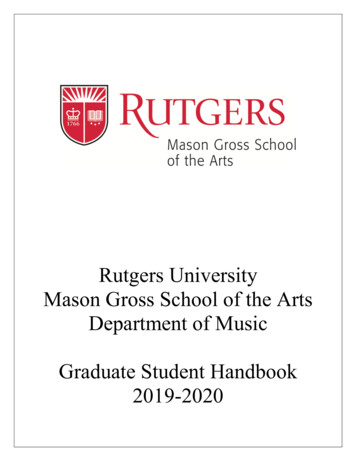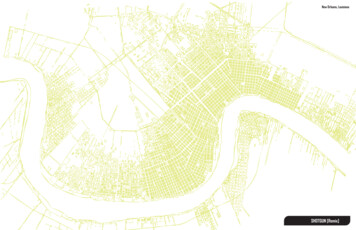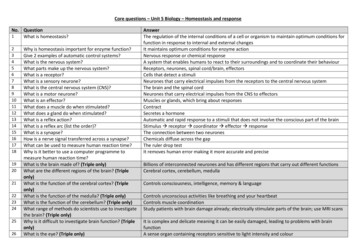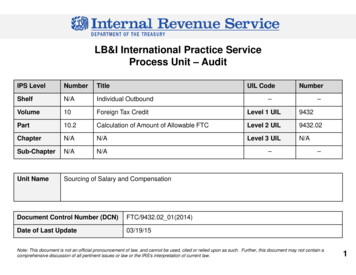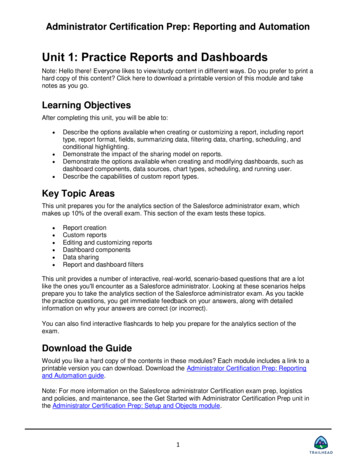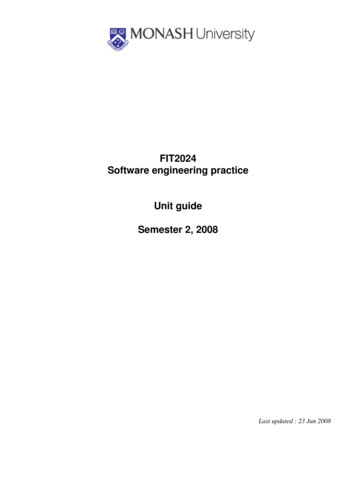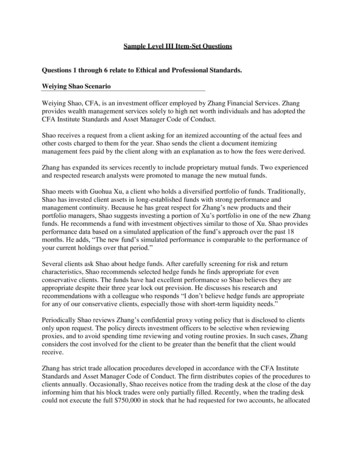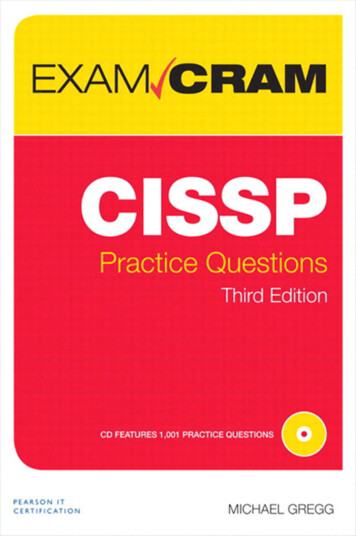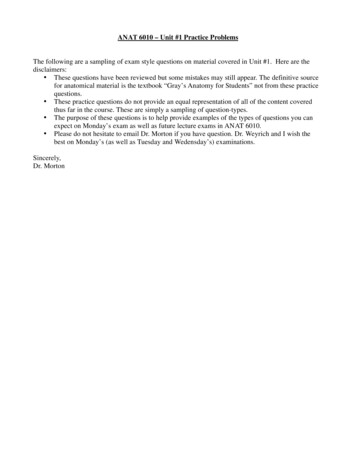
Transcription
ANAT 6010 – Unit #1 Practice ProblemsThe following are a sampling of exam style questions on material covered in Unit #1. Here are thedisclaimers: These questions have been reviewed but some mistakes may still appear. The definitive sourcefor anatomical material is the textbook “Gray’s Anatomy for Students” not from these practicequestions. These practice questions do not provide an equal representation of all of the content coveredthus far in the course. These are simply a sampling of question-types. The purpose of these questions is to help provide examples of the types of questions you canexpect on Monday’s exam as well as future lecture exams in ANAT 6010. Please do not hesitate to email Dr. Morton if you have question. Dr. Weyrich and I wish thebest on Monday’s (as well as Tuesday and Wedensday’s) examinations.Sincerely,Dr. Morton
1. A patient presents with weakness in his pectoralis muscles and a loss of sensation in the skin of his medialone-third upper arm and medial forearm. A lateral spine x-ray is taken. It is decided that the patient's symptomsare caused by a narrowing of the spinal column that is compressing an anteriorrami nerve root. The nerve root involved exits the spinal column above thevertebral bone labeled with the arrows. Assuming the patient has the correctnumber of vertebra, which nerve root is involved?A) C6B) C7C) C8D) T1F) T2A Incorrect, the arrows are pointing at T1.B Incorrect, the cervical region is the only region of the spine where the nerves, named after the vertebra inwhich they exit, exit above the vertebra they are named for instead of below them. C7 nerve is above the C7vertebrae.C Correct, there are 7 cervical vertebra and 8 cervical nerves. The cervical region is the only region of thespine where the nerves, named after the vertebra in which they exit, exit above the vertebra they are named forinstead of below them. The arrows are pointing to the T1 vertebrae so the nerve that exits above it will be theC8 nerve.D Incorrect, the thoracic nerves exit below the vertebrae they are named after.E Incorrect, the arrows are pointing at T1 so T2 nerve is lower.
2. A patent with a surgically fixed spine is x-rayed. The normal number of vertebral bones and ribs are seenalong with a metal fixation device (arrows are pointing to the metal fixation device). On the AP view the metaldevice covers which three vertebrae?A) T11, T12, T13B) T12, L1, L2C) T10, T11, L1D) T11, T12, L1A Incorrect, the thoracic spine only has 12 vertebrae.B Correct, the image on the left is the AP. T12 is determined from the last rib. The lumbar spine has 5 vertebraso you could count up from the bottom of the lumbar spine.C Incorrect, the thoracic spine has 12 vertebrae not 11.D Incorrect, the last rib is on T12 not T11.
3. A patient with a history of Tuberculosis comes to you complaining of lower back pain and clumsiness whenwalking. You order a lumbar spine x-ray which reveals Pott's diseases (TB of the spine). What would you tellthe patient based on the x-ray? (arrow pointing to the involved vertebra)A) The TB has infected your spine and is causing damage to the AnteriorTubercle of your L2 vertebrae.B) The TB has infected your spine and is causing damage to the Costal facets ofyour L2 vertebrae.C) The TB has infected your spine and is causing damage to the Pedical of your L2vertebrae.D) The TB has infected your spine and is causing damage to the MammillaryProcess of your L2 vertebrae.E) The TB has infected your spine and is causing damage to the VertebralBody of your L2 vertebrae.A Incorrect, this is an lumbar vertebrae it does not have an anterior tubercle.B Incorrect, lumbar vertebrae do not have costal facets.C Incorrect, the damage is to the body not the pecical.D Incorrect, the damage is to the body not the mammillary process.E Correct, the damage is to the vertebral body.
4. Which of the following CT images demonstrates the bifurcation of the trachea?(hint: Air black; Bone or contrastmaterial white; you view CT images as if patient is in anatomical position and you are looking from the patients feet)CT Image #3CT Image #1CT Image #2CT Image #4A) CT Image #1B) CT Image #2C) CT Image #3D) CT Image #4A Correct. This split is called the Carina. Image #1 is a slice through the mid thorax, it shows lung fields(black, seen on left and right), vessels full of contrast material (white round structures in the middle of theimage), and the Carina (black elongated tube right above the body of spine and in the middle of the vessels).B Incorrect, this CT slice is through the middle abdomen, it shows the kidneys (light gray, seen on right andleft) a small portion of the liver (seen on right) and intestines with contrast material (seen in top of image). Itdoes not show the lungs or the Carina.C Incorrect, this CT slice is through the lower abdomen, it shows a lumbar vertebrae, and lots of intestines. Itdoes not show any lung fields or the Carina.D Incorrect, this CT slice is through the upper thorax, it shows the beginning lung apexes (seen on right andleft side of vertebrae), shoulder bones (seen on right and left of image), the 1st rib (seen coming off spine andcircling around to top of image), and the unsplit trachea (black round tube seen in the middle of the image).
5. The below image is a digitally created 3D radiographic image showing the trachea, carina, and main bronchi(most of the lungs and the heart have been deleted from the image). When doctors push an ET tube past thecarina, it almost always goes down the right main bronchus. What anatomical features of the bronchi can beused to explain this?Constructed Response:Answer The right lung has three lobes and the heart does not take up space on the right so the right mainbronchus is wider and straighter.
6. Which of the following x-rays would be most diagnostically helpful in a patient with loss of sensation inposterior dermatome T11?Image #3Image #1Image #2Image #4Image #5A) Image #1B) Image #2C) Image #3D) Image #4E) Image #5A Incorrect, this is a lateral image of the cervical spine, notice the direction of the curve and the horizontalspinous processes. T11 is found in the thoracic spine.B Correct, this is a lateral image of the thoracic spine, notice the ribs. T-11 is found in the thoracic spine.C Incorrect, this is a lateral lumbar spine image, notice the large vertebral bodies, and the sacrum. T-11 isfound in the thoracic spine.D Incorrect, this is an axial thoracic spine CT image, a lateral image is better when trying to view thestructures that could pinch a nerve.E Incorrect, this is an AP thoracic spine image, a lateral image is better when trying to view the structures thatcould pinch a nerve.
7. A 22 year old bull rider comes to the ED complaining of chronic back pain, which he developed after hestarted riding bulls 3 years ago. You order a spine x-ray. On the x-ray you notice a deformity in the lumbarvertebrae, which you correctly diagnose as spina bifida occulta (an asymptomatic defect in the vertebral archwhich is most often found while imaging for a different problem). Which of the above images is your patient’s?Image 1Image 2Image 3Image 4A) Image 1B) Image 2C) Image 3D) Image 4E) Image 5A Incorrect, this is an image of C1 and C2. The odontoid is seen here.B Correct, this shows the Spina Bifida Occulta at the L5 level.C Incorrect, this is a normal image of the cervical spine.D Incorrect, this is a normal image of the thoracic spine.E Incorrect, this is a normal image of the L5 vertebrae.Image 5
8. A 27 year old female comes to the ED after being kicked in the chest by a horse. A chest x-ray demonstrates anenlarged heart shadow and a CT of the thorax demonstrates blood around the heart. The patient is diagnosed with acardiac tamponade. What structure is collecting the blood as it bleeds out of the heart?Enlarged heart shadowEnlarged heart shadowBlood outside heart.Blood outside heart.A) costodiaphragmatic recessB) costomediastinal recessC) pericardiumD) pleural cavityE) pleural cupolaA Incorrect, the costodiaphragmatic recess involves the lungs not the heart.B Incorrect the costomediastinal recess involves the lungs not the heart.C Correct, the pericardium is a sac that surrounds the heart. It feels with the blood around the outside of the heartduring a cardiac tamponade.D Incorrect, this involves the lungs not the heart.E Incorrect, this involves the lungs not the heart.
Use the following case study to answer the following two questionsA mother brings her 15-month-old boy to your office. She tells you that she saw a penny in the boy’s mouth andthat when she went to get it out, it was gone. She is worried that her child swallowed or inhaled the penny. APA and lateral chest x-ray reveals a coin in the superior mediastinum.9. After looking at the x-ray you tell the mother that the coin is located in the?A) esophagusB) larynxC) right main bronchusD) tracheaA Correct, the lateral x-ray shows the trachea (the black line in front of the coin with arrows)passing in front of the coin.B Incorrect, the larynx is not in the superior mediastinumC Incorrect, the right main bronchus is not in the superior mediastinum.D Incorrect, the trachea is seen on the lateral chest x-ray and the coin is not located in it.10. The mother asks how long it will take the coin to get to the stomach. You tell her that the esophagus hasareas where it is slightly narrowed by neighboring structures and that these areas are what take the longest forthe coin to pass. You tell her that the coin is now trying to pass the narrowing caused by the:A) arch of the aorta as it crosses the esophagus.B) esophageal hiatus.C) junction of the esophagus with the pharynx.D) left main bronchus as it passes over the esophagus.A Correct, the aortic arch crosses the esophagus in the superior mediastinum which can cause a narrowing inthe esophagus.B Incorrect, the esophagus passes through the diaphragm through the esophageal hiatus. The coin has not yetgotten to the diaphragm.C Incorrect, the esophagus and pharynx join in the neck. The coin has already passed this narrow spot.D Incorrect, the left main bronchus narrows the esophagus in the inferior mediastinum. The coin has not yetreached this spot.
11. The following barium swallow study (x-rays are taken of the esophagus as the patient swallows barium)shows esophagitis in a 57-year-old female. The arrows point to the swollen infected walls of the esophagus. Thepain this patient feels is transmitted by:A) somatic nerve fibers from the anterior vagal trunk.B) somatic nerve fibers from he posterior vagal trunk.C) visceral afferent nerve fibers from the vagus nerve.D) visceral efferent nerve fibers from he vagus nerve.E) visceral afferent nerve fibers that pass through the sympathetic trunks and the splanchnic nerves.F) visceral efferent nerve fibers that pass through the sympathetic trunks and the splanchnic nerves.A Incorrect, the anterior vagal trunk is made mainly from the fibers of the left vagus nerve and are not somatic.B Incorrect, the anterior vagal trunk is made mainly from the fibers of the right vagus nerve and are notsomatic.C Incorrect, the vagus nerve is involved with physiologic processes and reflex activities of the esophagus. It isnot involved in pain recognition.D Incorrect, same as C also efferent nerves take information out to the body.E Correct, esophageal pain is recognized by afferent nerve fibers that pass through the sympathetic trunks andsplanchnic nerves.F Incorrect, efferent nerve fibers carry information away from the CNS not toward it.
12. Referred pain is a condition where pain is felt in one part of the body but is actually coming from adifferent part of the body. This phenomenon is based on visceral sensory neurons and somatic sensoryneurons converging at the same vertebral level and confusing the brain of the pain’s origin. Aninflamed appendix, for instance, can cause painful stimulations in the umbilicus region [Snell, Richard.Clinical Anatomy by Regions. 8th edition]. What nerve is responsible for carrying the visceralsensation in the case of an inflamed appendix as described above?A. Intercostal nerve of spinal level T4B. Intercostal nerve of spinal level T10C. Least splanchnic nerveD. Lesser splanchnic nerveE. Phrenic nerveF. Vagus nerveAnswer:A. Incorrect. The intercostal nerves are responsible for general sensory, not visceral sensory.B. Incorrect. The intercostal nerves are responsible for general sensory, not visceral sensory.C. Incorrect. The least splanchnic nerve arises from the sympathetic trunk at the spinal level T12, andthe umbilicus is innervated by dermatome level T10.D. Correct. The dermatome level of the umbilicus is T10, and the lesser splanchnic nerve originatesfrom the sympathetic trunk at levels T10-11.E. Incorrect. The phrenic nerve innervates the diaphragm and is unrelated in this case.F. Incorrect. The vagus nerve originates from the brainstem, so it doesn’t cause referred pain.
13. Referred pain is a condition where pain is felt in one part of the body but is actually coming from adifferent part of the body. This phenomenon is based on visceral sensory neurons and somatic sensoryneurons converging at the same vertebral level and confusing the brain of the pain’s origin. Describethe referred pain that would be felt during ischemic (oxygen deficient) damage to the myocardialtissue.Answer: The visceral sensory to the heart is carried in sympathetic neurons arising from spinal levelsof T1-T4. The referred pain is felt at the dermatomes of these levels, which turns out to be the chestand medial portion of the arm.
14. A patient presents with labored breathing. It is determined that he has a nerve paralysis due tometastatic lung cancer that has invaded the parietal pleura where it comes in contact with thepericardium (Chest. 2003;123:97S-104S). Which nerve is most likely lesioned?A. Intercostal nervesB. Greater splanchnic nerveC. Left recurrent laryng
Use the following case study to answer the following two questions A mother brings her 15-month-old boy to your office. She tells you that she saw a penny in the boy’s mouth and that when she went to get it out, it was gone. She is worried that her child swallowed or inhaled the penny. A


